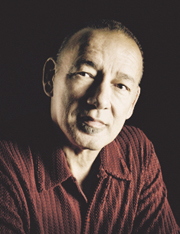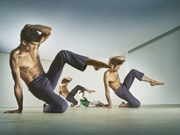Wonder Man

Neil Ellis Orts: What is it about these two pieces that goes together?
Joe Goode: Wonderboy is the story of the queer boy who discovers himself as an artist, discovers a way to use his sensitivity and his aesthetic feelings, and goes from feeling oppressed to feeling empowered: “I actually can do something a lot of people can’t do.” Obviously, a very personal story for me.
I collaborated with a puppeteer, Basil Twist, and it’s very much his story, too. So that moment when we discovered at puberty, or somewhere around there, that we had this power of making beautiful things and offering insights about the world through these beautiful things that we made, it was a kind of a redemption for both of us. We discovered that we were going to be okay.

With Maverick Strain, it’s very different. Maverick Strain is about Americans believing our rugged individual spirit kind of dominates all, that in the end, we’re going to walk off into the sunset with our mangy dog, victorious. I think that mythology is something that a lot of us live, against our better judgment. I wanted to point a finger at that, which is, in a way, kind of the opposite issue of the overly sensitive flower [in Wonderboy].
Do you have any thoughts on why dance in particular seems to attract gay men?
I have a piece called 29 Effeminate Gestures, which is about effeminacy. It’s about a lavishness of expression, a desire to make one’s gestures baroque or larger than life or dramatic, to expand feeling in a big way. I basically feel like gay men—many of us, not all of us—have that desire to express things deeply, to express things artistically even in gesture, even in the way we walk, in the way we wear our clothes. And dancing is kind of a natural extension of that. Absolutely.
I think the more interesting question is why—in the dance world that is populated by gay men—are there so few out gay choreographers? It is kind of shocking to me, even in this day and age that people still try to make this neutral, neutered kind of dance. I still feel like, in the residencies and the workshops that we do in the middle of the country, it’s this education process. People have never seen a woman lift a man or two men dance really tenderly and erotically together. And it’s like—why? What country are we living in?
I hope we’re coming into an era when that becomes less and less.
It’s funny, you know, because we went through this era, and I was very much a part of this era—the era of AIDS and dances about AIDS—and suddenly being gay or having two men and one of them dying became a real kind of topical possibility in dance. And everyone had an AIDS piece. I had 20 of them, but everybody had at least one. And I think there was some progress made there, but really, beyond the issue of death and dying, it’s really very hard to make a gay dance that people can look at and respond to, because they don’t have the eyes for it.
I’m in my mid-40s and I look at twenty-somethings who’ve grown up post- Ellen and post-Will & Grace and there is a whole different sensibility to them.
There is, and I hate to be the one to say the glass is half empty, but I do feel at the same time, to Letterman and Leno and all those popular culture people, gay is still a big joke. “That’s so gay” or “You must be a little light in the loafers.” The standard hasn’t changed that much. I’m still kind of shocked that the mainstream culture still has a long way to go.
Last year, I spoke with Bill T. Jones and he lamented that, for an American art form that has an enormous number of gay men participating in it, there are some cities where the gay community is completely oblivious to dance.
Most cities, yes, I totally agree with him. What you find mostly, unfortunately—and I think this is where, as a dance community in America, we’ve kind of failed—is your dance audience is mostly dancers. It’s mostly girls who studied ballet when they were little girls and then moved on to other things, but they still love dance and they bring their husbands. But you’re right, the gay men are not going out to see contemporary dance. I’ve worked very hard to cultivate them here in my hometown and I think I’ve succeeded, but outside of that it’s really tough. I think some of them are going to the opera and the ballet because it is a kind of validation: “I’m an elegant person, so I’m going to the opera and the ballet.” But the pieces they could be seeing that really are dealing with some issues that are familiar to them, and frankly dealing in a vernacular in movement and language that is more contemporary with their lives, they’re not necessarily getting out to see that stuff. And it’s just an education process.
I really feel like you can go into the theater with the expectation that something is going to happen to you…personally. That something is going to become dislodged or rearranged or some slight new perspective or something emotionally is going to open up or be revisited, something you kind of locked away. And that that experience can be a really powerful experience. Go with an appetite for that experience. I’m pretty sure, particularly with this piece of work, [OutSmart readers] get it.
Joe Goode Performance Group
The 75-minute program is presented at Wortham Center, 500 Texas, on March 6 at 8 p.m. Tickets ($20–$45) are available at spahouston.org, at 713/227-4SPA, or at Jones Hall (615 Louisiana).
Neil Ellis Orts is a regular contributor to OutSmart magazine.










